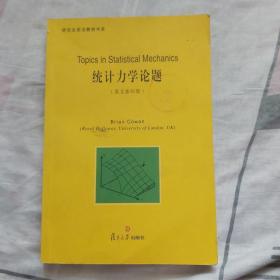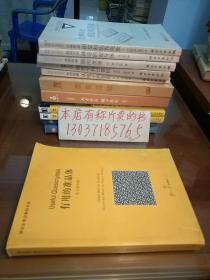
研究生前沿教材书系:统计力学论题(英文影印版)
¥ 98 八五品
仅1件
作者科恩(Brian Cowan) 著
出版社复旦大学出版社
出版时间2006-11
版次1
装帧平装
上书时间2021-01-06
- 在售商品 暂无
- 平均发货时间 21小时
- 好评率 暂无
- 最新上架
商品详情
- 品相描述:八五品
图书标准信息
- 作者 科恩(Brian Cowan) 著
- 出版社 复旦大学出版社
- 出版时间 2006-11
- 版次 1
- ISBN 9787309052015
- 定价 35.00元
- 装帧 平装
- 开本 16开
- 纸张 胶版纸
- 页数 319页
- 正文语种 英语
- 【内容简介】
-
伦敦地区的几所大学,在硕士研究生的最后一年,都要联合起来,通过网络教育的方式,给硕士生讲授几门统一的高级课程,《统计力学论题》就是其中的教程之一。本门教程在成书之前,作者已经系统地讲授了十多年,成书过程中又组织学生、同行和由出版社委派的专家一道,对书稿提出许多建议,然后再修改而成现在这个样子。
全书用一种统一的观点处理热力学和统计物理论题。第一、第二章分别讲述统计力学的方法论和理想体系的实际计算。其中差不多有一半内容属于本科期间已有的基础知识,但采用更高的、完全用统一的观点,看待热力学和统计力学。第三章非理想气体,重点讲述维里展开、配分函数、节流和状态方程。第四章相变,介绍相图、对称性、序参量、临界指数、标度理论、一级相变、二级相变、伊辛模型、朗道理论、铁电体、二元混合物、量子相变、平均场理论等等。这是全书的重点。第五章讲述涨落和动力学行为,重点是涨落的关联特性、布朗运动、朗之万方程和线性响应理论。各章末尾都安排一定数量的习题,习题解答可通过 - 【作者简介】
- BrianCowan,物理学教授,伦敦大学皇家Holloway学院物理系系主任。毕业于英国Sussex大学物理系,曾先后就职于诺丁汉(Nottingham)大学和巴黎(Paris)大学,致力于核磁共振(NMR)的理论和实验研究,著有NuclearMagneticResoˉnanceandRelaxation(CambridgeUniversityPress,1997)等著作。
- 【目录】
-
TheMethodologyofStatisticalMechanics
1.1TerminologyandMethodology
1.1.1Approachestothesubject
1.1.2Descriptionofstates
1.1.3Extensivityandthethermodynamiclimit
1.2TheFundamentalPrinciples
1.2.1Thelawsofthermodynamics
1.2.2ProbabilisticinterpretationoftheFirstLaw
1.2.3Microscopicbasisforentropy
1.3Interactions--TheConditionsforEquilibrium
1.3.1Thermalinteraction--Temperature
1.3.2VolumechangePressure
1.3.3Particleinterchange--Chemicalpotential
1.3.4Thermalinteractionwiththerestofthe
world--TheBoltzmannfactor
1.3.5Particleandenergyexchangewiththerest
oftheworld--TheGibbsfactor
1.4ThermodynamicAverages
1.4.1Thepartitionfunction
1.4.2Generalisedexpressionforentropy
1.4.3Freeenergy
1.4.4Thermodynamicvariables
1.4.5Fluctuations
1.4.6Thegrandpartitionfunction
1.4.7Thegrandpotential
1.4.8Thermodynamicvariables
1.5QuantumDistributions
1.5.1Bosonsandfermions
1.5.2Grandpotentialforidenticalparticles
1.5.3TheFermidistribution
1.5.4TheBosedistribution
1.5.5Theclassicallimit--TheMaxwelldistribution
1.6ClassicalStatisticalMechanics
1.6.1Phasespaceandclassicalstates
1.6.2BoltzmannandGibbsphasespaces
1.6.3TheFundamentalPostulateintheclassicalcase
1.6.4Theclassicalpartitionfunction35
1.6.5Theequipartitiontheorem
1.6.6Consequencesofequipartition
1.6.7Liouvillestheorem
1.6.8BoltzmannsHtheorem
1.7TheThirdLawofThermodynamics
1.7.1HistoryoftheThirdLaw
1.7.2Entropy
1.7.3Quantumviewpoint
1.7.4Unattainabilityofabsolutezero
1.7.5Heatcapacityatlowtemperatures
1.7.6OtherconsequencesoftheThirdLaw
1.7.7Pessimistsstatementofthelawsof
thermodynamics
PracticalCalculationswithIdealSystems
2.1TheDensityofStates
2.1.1Non-interactingsystems
2.1.2Convertingsumstointegrals
2.1.3Enumerationofstates
2.1.4Countingstates
2.1.5Generalexpressionforthedensityofstates
2.1.6Generalrelationbetweenpressureandenergy
2.2IdenticalParticles
2.2.1Indistinguishability
2.2.2Classicalapproximation
2.3IdealClassicalGas
2.3.1Quantumapproach
2.3.2Classicalapproach
2.3.3Thermodynamicproperties
2.3.4The1/N!terminthepartitionfunction
2.3.5Entropyofmixing
2.4IdealFermiGas
2.4.0Methodologyforquantumgases
2.4.1Fermigasatzerotemperature
2.4.2Fermigasatlowtemperatures--simplemodel
2.4.3Fermigasatlowtemperatures--seriesexpansion
Chemicalpotential
Internalenergy
Thermalcapacity
2.4.4Moregeneraltreatmentoflowtemperature
heatcapacity
2.4.5Hightemperaturebehaviour--theclassicallimit.
2.5IdealBoseGas
2.5.1GeneralprocedurefortreatingtheBosegas
2.5.2Numberofparticles--chemicalpotential
2.5.3LowtemperaturebehaviourofBosegas
2.5.4ThermalcapacityofBosegas--belowTc
2.5.5Comparisonwithsuperfluid4Heand
othersystems
2.5.6Two-fluidmodelofsuperfluid4He
2.5.7Elementaryexcitations
2.6BlackBodyRadiation--ThePhotonGas
2.6.1Photonsasquantisedelectromagneticwaves
2.6.2Photonsinthermalequilibrium--black
bodyradiation
2.6.3Plancksformula
2.6.4Internalenergyandheatcapacity
2.6.5Blackbodyradiationinonedimension
2.7IdealParamagnet
2.7.1Partitionfunctionandfreeenergy
2.7.2Thermodynamicproperties
2.7.3Negativetemperatures
2.7.4Thermodynamicsofnegativetemperatures
3Non-IdealGases
3.1StatisticalMechanics
3.1.1Thepartitionfunction
3.1.2Clusterexpansion
3.1.3Lowdensityapproximation
3.1.4Equationofstate
3.2TheVirialExpansion
3.2.1Virialcoefficients
3.2.2Hardcorepotential
3.2.3Square-wellpotential
3.2.4Lennard-Jonespotential
3.2.5SecondvirialcoefficientforBoseandFermigas
3.3Thermodynamics
3.3.1Throttling
3.3.2Joule-Thomsoncoefficient
3.3.3Connectionwiththesecondvirialcoefficient
3.3.4Inversiontemperature
3.4VanderWaalsEquationofState
3.4.1Approximatingthepartitionfunction
3.4.2VanderWaalsequation
3.4.3Microscopic"derivation"ofparameters
3.4.4Virialexpansion
3.5OtherPhenomenologicalEquationsofState
3.5.1TheDietericiequation
3.5.2Virialexpansion
3.5.3TheBerthelotequation
4PhaseTransitions
4.1Phenomenology
4.1.1Basicideas
4.1.2Phasediagrams
4.1.3Symmetry
4.1.4Orderofphasetransitions
4.1.5Theorderparameter
4.1.6Conservedandnon-conservedorderparameters
4.1.7Criticalexponents
4.1.8Scalingtheory
4.1.9Scalingofthefreeenergy
5FluctuationsandDynamics
Appendixes
index
相关推荐
-

研究生前沿教材书系:统计力学论题(英文影印版)
八五品上海
¥ 85.00
-

研究生前沿教材书系:统计力学论题(英文影印版)
八五品北京
¥ 38.00
-

研究生前沿教材书系:统计力学论题(英文影印版)
八五品上海
¥ 45.00
-

研究生前沿教材书系:加速器物理学(第2版)
八五品南京
¥ 290.00
-

研究生前沿教材书系:统计力学论题(英文影印版)
全新长沙
¥ 156.00
-

研究生前沿教材书系:统计力学论题(英文影印版)
九五品蚌埠
¥ 75.00
-

研究生前沿教材书系:统计力学论题(英文影印版)
九五品温州
¥ 100.00
-

研究生前沿教材书系:统计力学论题(英文影印版)
全新天津
¥ 98.00
-

研究生前沿教材书系:有用的准晶体(英文影印版)
八五品武汉
¥ 99.00
-

研究生前沿教材书系:现代量子光学基础(英文影印版)
九品贵阳
¥ 22.00
— 没有更多了 —





















以下为对购买帮助不大的评价